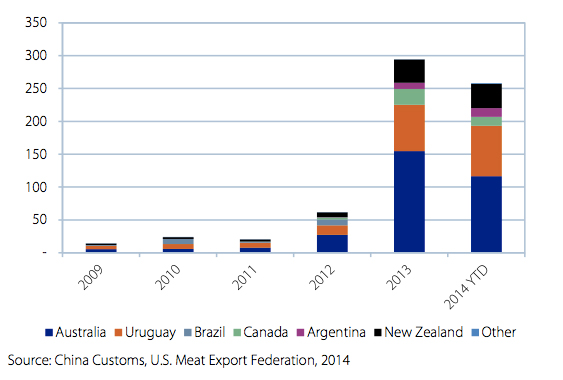
China sent waves through global beef markets in 2013 when they increased their official imports by 380% YOY.
Recent announcements of an FTA with Australia and a re-opening of trade with Brazil raises the question of whether this will unleash another boom year in official Chinese imports in 2015. Rabobank does not expect the FTA to dramatically impact import volumes in 2015, but the agreement with Brazil will draw volumes out of the grey channel into official Chinese imports, with imports increasing moderately in 2015.
The 2013 increase in official Chinese beef imports was unprecedented. It can be attributed to both longer-term structural trends and short-term policy changes that combined to see imports explode.
A number of food safety scandals emphasised the need for food safety and traceability, with authorities encouraging trade through official channels rather than the unofficial ‘grey channel’. Furthermore, stagnant domestic beef production, rising Chinese demand, moves by China and key trading partners to establish export protocols and accredit processors over preceding years, and relatively cheaper beef from Australia due to drought-induced herd liquidation all encouraged beef to flow directly into the Chinese market.
Following the surge in 2013, beef imports stabilised in 2014 at these new levels.
What will happen in 2015?
On 17 November, China and Australia announced an FTA that would see tariff rates on beef reduced from between 12% to 25% to zero over a nine-year period. While this will give Australia a significant price advantage over the longer term, it is unlikely to have any immediate impact on trade volumes, particularly in light of tightening Australian supply and continued US demand.
On 16 November, the Chinese and Brazilian governments agreed to re-open the official beef trade between the two countries, following closure in December 2012, after a single atypical case of BSE in the Parana state of Brazil.
Based on the volumes of Brazilian beef that have gone into Hong Kong in 2013 and 2014 after the closure of the official trade in 2012, all things being equal, re-opening the trade will redirect product away from the grey channel to official channels.
There are a number of factors that will impact the degree of substitution between the official and grey channels for Brazilian beef trade. Shipping directly into China, Brazilian exports will face a 12% to 25% tariff and will also need to be sourced through accredited processing facilities. Also, the Russian-imposed trade sanctions on major beef exporting nations have resulted in a greater reliance on exports from Brazil, as their largest supplier.
Given greater global competition for beef, Russia’s reduced beef import base and devaluation of the ruble, the willingness of Russia to compete with China will determine how much additional beef Brazil has available to supply China.
China’s rise as a beef import superpower in 2013 w as due to a confluence of events unprecedented in their timing. While in 2015, the possibility remains that a shift from the grey market channel to the official channel will see a significant increase in Chinese beef demand, it is not expected to be of the
same magnitude experienced in 2013. Furthermore, while the official statistics may reflect an increase, the underlying Chinese demand for beef will remain strong and will increase at a steadier rate, providing a great export opportunity for a number of beef-exporting countries.
